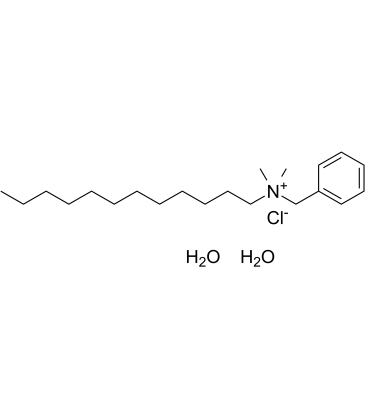| In Vitro |
Benzyldodecyldimethylammonium chloride dihydrate (1-10 μM; 2 hours) results in a dose-dependent changes in the percent population of dead rat thymocyte cells[1]. Benzyldodecyldimethylammonium chloride dihydrate (0-40 mg/L; 0-24 hours) inhibits P. fluorescens with a MIC of 20 mg/L. At 5 mg/L, cells have the same growth behaviour as the control. At concentrations of 10 and 15 mg/L the growth profile is different from the control, and the cells start to grow only after 8 h of adaptation. At concentrations of ≥20 mg/L, BDMDAC inhibits cell growth[2]. Benzyldodecyldimethylammonium chloride dihydrate interacts strongly with cell surfaces in a concentration-dependent manner, and binds by ionic and hydrophobic interactions to microbial membrane surfaces, as manifested by phenomena such as membrane disruption and loss of membrane integrity with consequent leakage of essential intracellular constituents, which promote significant and irreversible changes in the cell structure[2]. Cell Viability Assay[1] Cell Line: Rat thymocyte cells Concentration: 0, 5, 10, 15, 20 and 40 mg/L Incubation Time: 2 hours Result: Resulted in cell death. Cell Proliferation Assay[1] Cell Line: Bacterial P. fluorescen Concentration: 0, 5, 10, 15, 20 and 40 mg/L Incubation Time: 2 hours Result: Inhibited bacterial growth in a time and dose dependent manner.
|
